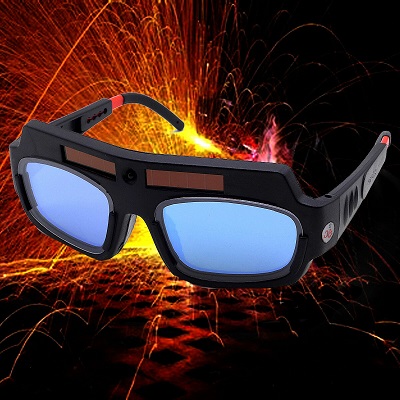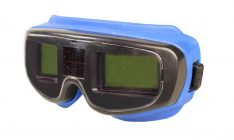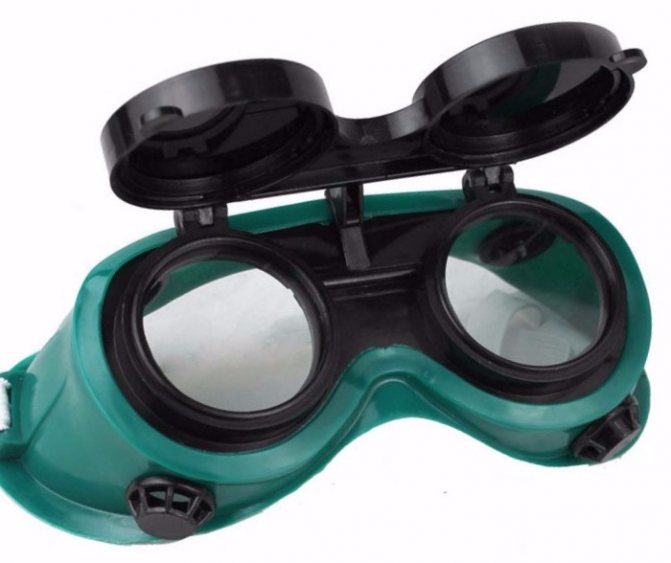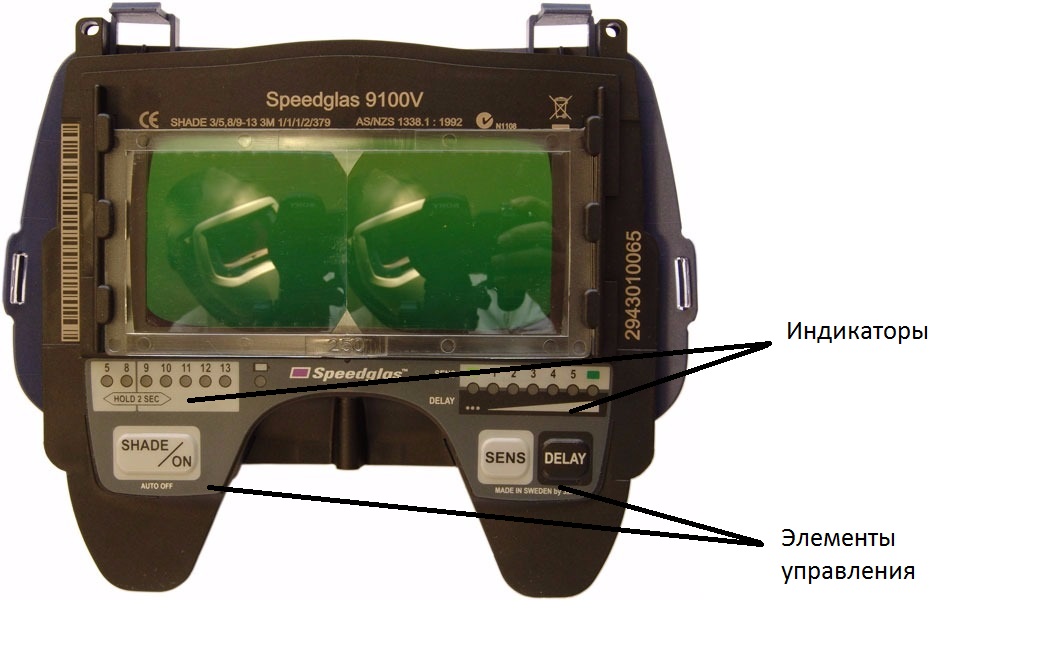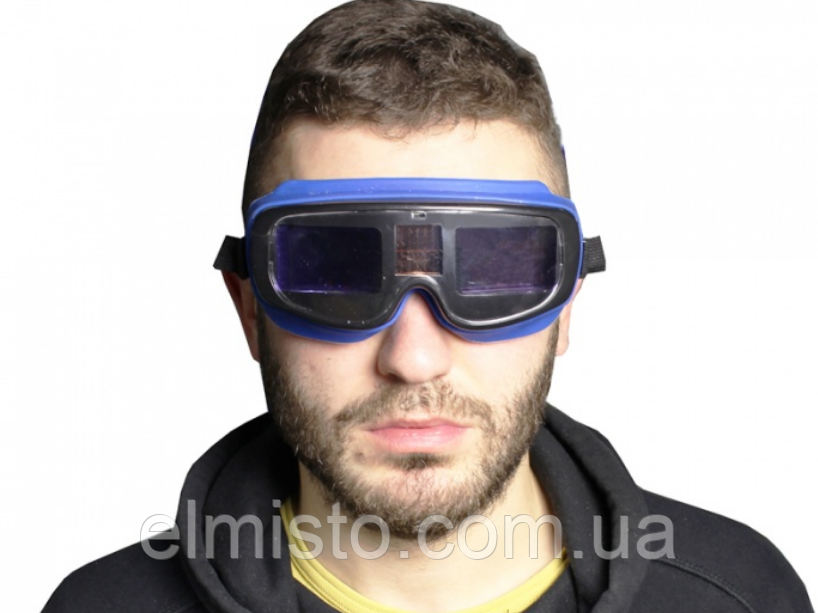Filter faults
Something is wrong with the light filter:
- If the shading is not the same on the right and left, that is, uneven, you need to adjust the distance between the eyes and the welding glass.
- The filter flickers and does not darken. The most common reason for this is glass contamination or defect. In this case, it must be cleaned or replaced. If you are working with low current, set the filter to "slow".
- Low sensitivity of the filter can be observed at low air temperatures, usually such a boundary is minus 5 ° C.
- The reason for poor visibility is most often elementary - it is dirty glass. Or, the dimming setting is incorrect.
When to wear
It is advisable to use protective goggles when the use of a welding mask is impossible due to the limited space at the place of welding. Sometimes welding goggles are used in order to reduce the intensity of the load on the cervical spine during work.
The goggles are much smaller than the welding helmet, and their weight is also significantly different from its weight. These are, perhaps, the only advantages of glasses, since their protective properties are limited only by the protection of the retina of the eyes and the skin around them from the influence of ultraviolet and infrared radiation, as well as from the mechanical effects of molten metal particles, dust and smoke.
However, very often the working environment requires the welder to use just this type of protection.
Now the light filter
The light filter can rightfully be called the main part of the welding mask. Modern light filters can differ both in their size and in the degree of shading. Their design depends on the mask model and, of course, on the characteristics and types of the welding process.
The most advanced models of modern light filters are chameleons, which are suitable for almost all types of welding work.
The classification of welding glass is simple:
- Permanently dimming glasses.
- Changeable shade glasses.
- Diopter lenses for welding equipment.
Permanent Dimming Filters
These are classic and long-familiar models for welders. Nickel or copper is added to glasses for welding masks as additional chemical constituents. These additives are the main dimming factors, they reduce the transmission of glass to light. Another option is a mirrored surface for reflecting light rays.

Protective filter.
Filters with fixed dimming come in two degrees: Western DIN and domestic C. The dependence of the degree of dimming on the current strength is as follows: the more amperes, that is, the current, the higher the degree of shading of the glass should be in the mask. With the disadvantages of this type of mask listed above, there are significant advantages. First of all, these are strength, durability and low cost.
Interchangeable dimming filters
Chameleons are new generation glasses. They were invented to get rid of the main disadvantage of older models with non-replaceable glass - the need to manually lift the glass outside the welding process: to, for example, remove slag or clean a seam. Chameleons with automatic dimming a few thousandths of a second before igniting an electric arc are quite another matter.
A chameleon can have up to three such screens with an additional screen film to protect against ultraviolet and infrared radiation. And that's not all: an additional polymer layer is designed to protect against molten metal droplets.
Here are the advantages and features of a chameleon filter for a welding mask:
- The use of liquid crystal technology. Chameleon filters are made of a layer of liquid crystals with a special polarizing film. As light rays pass through, these crystals line up in a strict order, thus blocking the light from becoming polarized.
- The danger of eye injury during welding is due to two types of radiation - ultraviolet and infrared spectra. A correctly adjusted light filter without a polarizing film protects perfectly against them. But if, God forbid, such filters fail, their protection against UV and IF becomes zero. But chameleons will protect you even when out of order: additional filters are built into its design.
- Chameleons are extremely sensitive to ambient temperature: they lose their functional properties at temperatures below 5 - 10 ° C. This is because the polarizing layer by its nature "works" several times slower in a cool environment.
- The degree of sensitivity of the chameleon filter. In other words, this is the triggering threshold of the welding mask, depending on the brightness of the electric arc. This level is perfectly adjustable: in the settings, you can even exclude the automatic operation of the filter in bright sunlight.
- The filter closing delay also prevents the chameleon from automatically triggering in response to the bright glow of the hot metal. The same property helps to avoid fading or flashing of the light filter during short stops of the welding process. This kind of adjustment is very important in modern welding conditions: after all, the electric arc has a very different brightness depending on the type of work. Most common filter shade rate 9 - 13
Diopter lenses
This option is intended for special work with small parts or thin metal. In addition, they are shown to people with vision problems. Diopters enlarge the image of objects for convenient control of the welding process.
How to choose welder glasses
The choice of the type of personal eye protection equipment depends on the conditions and nature of the welder's performance of his professional duties:
- High and medium power welding work. A professional needs goggles with a high degree of obscuration.
- Welding work in open and ventilated areas. In these conditions, a reasonable solution would be to use open chameleon glasses with protective light filters and a folding mechanism in order to inspect the welding working area without removing special equipment.
- The combustion temperature of the gas differs from that of the electric arc. Therefore, different light filters are used for gas welding and electric welding.
- Goggles for an electric welder should have darker lenses than their equivalent for a gas welder. The light filter for gas welding has a high transmittance, it is less dark. Gas welder goggles cannot be used for performing electric welding work.
High-quality cutting glasses provide maximum protection against harmful factors: mechanical damage, reliable darkening during the entire process of working with hot metal.
In addition to the means that are used to protect against damage to the organs of vision, there is a large list of protective clothing required for the work of a welder.
Peculiarities
Before you buy welding goggles, you should pay attention to some characteristics:
- the body of the glasses should fit snugly against the skin;
- glasses must be durable, at least 3 mm thick, which guarantees the preservation of the organs of vision from damage by metal particles;
- good visibility during work;
- the frame with the "chameleon" does not jam and easily leans back;
- low weight of the device.

Given these features, buying glasses will not turn into torture. Be sure to remember that the dimming speed is much slower when operating in cold conditions. Do not weld at temperatures below -10 ° C degrees.
Welding goggles are comfortable and attractive in many ways. Feedback from the owners of this device is mostly positive. But buying a mask or glasses is a personal choice of the master. With long work, the glasses will protect only the eyes themselves, but the face itself will remain defenseless. If, nevertheless, it is decided to purchase glasses, then purchase them in a specialized store in order to reduce the risk of buying a low-quality device.
Choosing glass for a welding mask
We already know that the glass for the welding helmet is the main factor in protecting the eyes of the welder.

Filter marking for mask.
For a targeted choice, there are special tables with various characteristics that will simplify making a competent decision:
Functional purpose of glass.
The types of welding are listed here depending on the parameters of the welding current, power indicators, additional functions, and so on.
Light beam visual filter factor.
depends on the type of welding, this is the main criterion for classifying glass.
Glass marking
There are strict standards for the classification of technical glass:
B1, B2, B3.
These are filters for use in auxiliary work in the gas welding process.
G1, G2, G3.
A group of filters for performing direct welding work.
From E1 to E5.
And these filters are designed for electric welding.
C3 to C8.
This is the label for all Chameleon filters.
Resistance classification
In addition to the type of work, welding glasses are classified according to their resistance to mechanical stress and scratches on the surface.
Special attention should be paid to the tendency to scratches: their appearance on the filter can also lead to a sharp deterioration in the functions of the welding helmet.
The choice also depends on the type of equipment you plan to work on. You should not buy products without labels and at a cheap price. It's simple: good equipment cannot be cheap, especially when it comes to technical glass.
If, for example, there is not enough money for branded chameleons, it is better not to buy their cheap version, but to opt for a simple filter with permanently dimmed glasses.
If there is no visual difference between the filters, drop these filters and say goodbye to the seller. It is better not to deal with fakes.

A table of recommendations for choosing a mask.
Professionals usually have several different mask filters to change during welding to determine the best option for a particular moment.
When choosing welding helmets with fixed shading, in addition to the current strength, you must also take into account the type with the electrode number.
If you are doing welding at home and from time to time, it will be most optimal to choose a mask with the most versatile filter. To do this, it is better to choose shading with parameters of at least 10 DIN - these are types from C4 and above.
If there is a choice among masks - chameleons, then the three most important factors should be taken into account:
- The degree of active dimming, it is better to choose at least 9.
- Glass darkening speed. Average normal speed is about 0.1 seconds.
- The back-coating speed of the filter.
An extensive selection of welding helmets on the market, on the one hand, helps in the correct solution, on the other hand, it introduces certain difficulties. One way or another, a mask of any type and cost must be marked and indicated technical parameters.
And here is GOST, where to go
There is no need to go anywhere, there are GOSTs for welding protective masks, and thank God, let's rejoice at this fact. Because the correct models with all the constituent elements are no joke to you.
It was changed periodically and it still works fine.According to the format of this GOST, we will deal with both basic concepts and technical nuances related to masks, shields, glasses, light filters and everything else related to eye and face protection during welding.
So, the welding mask consists of two parts: these are plastic cases and special filters for welding helmets. Most often they are sold together, but separately glass for welding is also offered.
Additional features are present on dedicated air assisted welding helmets designed for heavy duty applications. Also on the market are simply goggles for gas welding - a protective device without a body to protect the face.
 Chameleon mask.
Chameleon mask.
The housing itself has requirements that are easy to understand: the material of manufacture must be resistant to splashes of molten metal, to sparks, and in addition, it must not conduct electric current under any conditions. Typically, housings are made from a wide variety of plastics or fiber.
The most important and understandable criteria for choosing a suitable model are:
- weight and dimensions;
- the size of the headgear, the angle of inclination;
- planting depth;
- the presence of adjustment of the angle of inclination or depth of planting, its quality;
- adjustment of the distance between the filter and the face;
- reliability of the regulation system.
The light filter for a welding helmet can be of a wide variety of shapes - from round to rectangular. The material of manufacture is most often organic glass or polycarbonate. In order to choose the right mask for welding, it does not hurt to understand the nuances of the ultraviolet and infrared spectra of radiation.
Exploitation
Welding goggles and any other protective equipment should be worn before starting work at the time of preparation for them. Before that, you must familiarize yourself with the operating instructions that are attached to the product by the manufacturer. Before starting to work with glasses "chameleon" you need:
- conduct a thorough inspection of the product: make sure there are no mechanical damages, breaks in the electrical wiring (loop);
- individually adjust the glasses: adjust the opening-closing of the light filter using the clamps, snug fit of the glasses to the face around the eyes;
- check the charging of the batteries so that they do not fail at a crucial moment of work.
During operation, the operation of the electronic light filter should be monitored, relying on the comfort of vision. If there are no glare, characteristic "bunnies", then the glasses work efficiently and in a timely manner switch from one mode to another. For glasses with conventional filters, the performance requirements are the same, taking into account the simpler design. It is also necessary to check the serviceability, integrity, reliability of the folding device, individual settings of the occipital belt. Any doubt should be construed as a contraindication.
The light filters can be thrown back only when the radiation has completely ceased. Better to waste a few seconds than hurt your eyes.
In the next video, you will find a detailed overview of the automatic darkening welding goggles.
Application
As you know from the name, miracle glasses have found their application in the welding field. They are convenient to use when carrying out work with arc welding or semiautomatic devices.
To do this, when buying glasses, you should pay attention to the degree of shading, medium is enough (level 3 or 4). Note that each type of welding has its own standards for shading welding glasses.
The main situations with the use of protective welding goggles is when you need to put a small (short) seam, but it is not possible to get close to it with a mask.
It is due to the fact that with any welding method, you can get injured from splashes and small particles of red-hot metal. When working with seams below chest level, the likelihood of injury is reduced, and it is almost impossible to get a burn to the face.

It should be emphasized that the use of goggles for welding is recommended when working with gas welding, or when plasma cutting metal. It is not recommended to use them for electric welding.
This is due to the particularly strong radiation and the large splash area of metal particles.
Views
Each specialist has his own requirements for protective equipment. Everyone chooses what he considers necessary, as well as with goggles for gas welding.
The most budgetary and simpler design model is glasses with permanently darkened light filters. Outwardly, they are two eyepieces, fastened together with a strap, or framed by a light body. This design provides a wide view even from the side, and is fixed on the head with a special elastic band.

It is convenient to work in such glasses, except that when assessing the quality of the seam, they will have to be removed. Storing glasses of this type is very simple, just roll up and put in your ammunition pocket.
The second type is a rigid case with a folding frame. This model is a little more expensive, but it makes it possible to assess the quality of the seam without removing the device. A frame with transparent but durable glass is located under the tinted light filters. The hinged cover allows you to change the view with a single movement of the hand.
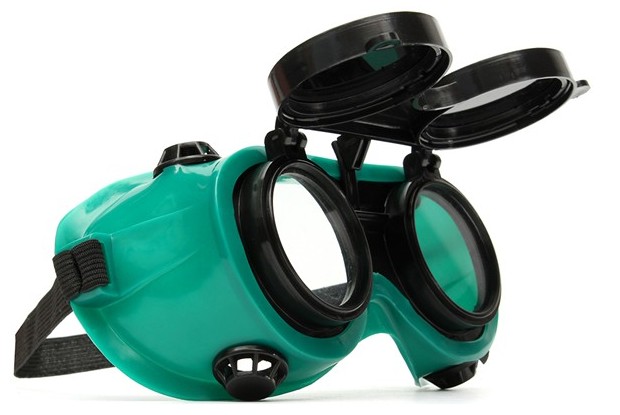
The third and most expensive type is the auto-dimming glasses, the so-called "chameleons". The price for this model is quite high, but the demand is not small either. They are worth considering in more detail.
In appearance, the chameleon goggles resemble a diving mask. The body is made of durable refractory plastic, there are ventilation holes around the perimeter, thanks to which the eyes do not water and there is no fogging from the inside.

Glasses of this type have both built-in durable transparent glasses and a hinged frame with automatically darkening liquid crystal filters.
In the inactive state, the light transmittance is similar to sunglasses, but with a sharp change in illumination, and this is what happens with a welding flash, the crystals are ordered, which provides optimal darkening for a particular type of welding.

These super glasses are powered by "solar" batteries that store energy from bright lighting. Some models have a built-in control unit that allows you to change the level and speed of dimming.
Choosing a manufacturer
First you need to deal with the manufacturing companies: which of them can you trust unconditionally?
3M and Speedglas.
The famous line of welding helmets from the most powerful American company, which took its name from the Minnesota Mining and Manufacturing Company. The Speedglas line includes a variety of masks, additional filters, shields, special protection plates and so on. In Russia, 3M products are manufactured under the 3M Russia brand.
Svarog.
Resant.

The company produces welding helmets with automatic replaceable chameleon filters. The range of masks is wide and varied: there are tools for almost all types of welding.
Fubag.
The products of the German concern do not need special advertising. The company produces a lot of things for construction and repair, but welding equipment, including protective masks, occupies a special place.
Brima.
Another German company with rich experience in the production of welding equipment for both amateurs and professionals.
These products have a well-developed service network in Russia, which is very important.
Quattro Elementi.
Criterias of choice
The choice of glasses is dictated by the type of welding, working conditions and, of course, the amount of money available to the buyer. If "smart" glasses "chameleons" can be used for both arc and gas welding, then the usual ones are mainly applicable for gas welding. Their filters are too weak to radiate an arc.If the work is carried out in the open air and the surfaces to be welded are below the welder's head, simple protective goggles are sufficient. Daylight is more scattered and less harmful to the eyes. Open air reduces the concentration of harmful substances emitted during welding, which irritate the eyes.
In all cases, flip-up glasses are preferable. It is better to provide glasses with stationary filters to the assistant. Accordingly, for indoor work, “chameleons” with additional shields protecting parts of the face are preferable. For welding "above the head", most likely, you will have to purchase a protective welding helmet, so as not to damage the scalp, not to singe the hair, to prevent sparks and hot scale from getting behind the collar.
Chameleon glasses on the Russian market are mainly made in China. They cost approximately 450 to several thousand rubles. Cheap models have quality complaints. "Chameleons" is the best option for those who are professionally engaged in welding.
When choosing, you should pay attention to the power supply system of the product. It is desirable that there are two of them - the main and the backup.
Battery and photocell. This will save you from sudden failures. In addition, it is necessary to pay attention to the response speed of the electronic filter. It must be less than 1 millisecond. If more, this is already a high risk of retinal injury.
Regular glasses, depending on the model, cost from 100 (the most elementary, suitable, rather, not for the welder, but for his assistant) to 2000 rubles (with folding light filters)
It is important to choose the "golden mean" here. Such glasses are purchased by those who are engaged in welding irregularly, who need, for example, to build a frame for a fence in the country or something like that.
It is recommended to choose glasses with the possibility of changing light filters.
The main thing, with any choice, is not to forget about safety precautions. Glasses must reliably protect the eyes from radiation. Welding goggles should fit snugly around the face around the eyes in the manner of a diver's mask. This will save you from side glare. Glasses without a snug fit are more suitable for metal cutting, stripping and other work not related to welding. It should be remembered that welding is classified as particularly harmful to health. Failure to understand this and hope for "maybe" can lead to loss of vision.
Model overview
The modern market offers a wide variety of models of welding goggles. From relatively cheap ones - simple ones with elementary light filters - to complex ones with replaceable filters and even liquid crystal elements. These, of course, are much more expensive.
Welding goggles "chameleons" with auto-darkening glass are now considered the most popular. Their peculiarity is that the filters are automatically dimmed with bright flashes. "Chameleons" are universal: they can be used in gas and arc welding. It is the brainchild of modern electronic technology. The protective screen is a complex device consisting of polarizing films and liquid crystals. With a sharp change in illumination (flash), the control unit sends a signal to the protective device, the liquid crystals change their position. This also changes the position of the polarizing films. As a result, blackout occurs. When the flame (arc) is extinguished, the automatic filters become transparent and allow, without removing glasses, to visually control the quality of welding.


A simpler option is glasses with permanent filters. Most often this is a non-separable design, and such glasses must be removed for careful control of welding. Light filters can be made of high-strength glass, as well as of polymer materials. They have different shades of shade and are used depending on the type of welding and working conditions.
Glasses with drop filters are much more comfortable for the welder.Two round lenses are attached to the eyepieces of glasses on special hinges. If necessary, they rise to the forehead of the master and allow you to inspect the place of welding and the quality of the seam. This saves time and effort: removing and putting on glasses - especially in the cold season and with full working equipment - is a rather complicated procedure.
Automatic self-darkening filter "Chameleon"
Automatic self-darkening filter (AFF) "Chameleon" is a complex electronic device, the "highlight" of which is a multilayer package of polarizing films ("glass" through which you look when welding). The bag is placed in metal plates to form a cartridge. Layers of liquid crystal structures (LCS) are located between the layers of these films. If the cartridge is exposed to an electromagnetic field (EMF), then the FSW change their spatial position. This changes the transparency of the entire cartridge.
For the formation of an EMF, an electric voltage is supplied to the cartridge plates from the control unit (CU). The magnitude of this voltage depends on the illumination of the light sensors (CC) located on the surface of the protective welding device (welding goggles, welding mask, etc.). SS, in turn, react to the illumination of the working area, which changes sharply when the welding arc is ignited or attenuated.
The principle of operation of ASF "Chameleon" is as follows. The corresponding signal is sent from the SS to the control unit. The latter, by changing the voltage on the cartridge plates, changes the transparency of the protective "glass" of the device.
BU is located in the body of the protective welding device. The interface with controls is located on its surface (external and internal). The power supply is provided by lithium and solar panels (this significantly increases the battery life).
ASF "Chameleon" has a high speed:
- - blackout time, msec:? 0.1;
- - clearing time (with an adjustable delay for the cooling time of the weld pool), sec: 0.1 ... 1.0.
This device protects the welder's health. ASF "Chameleon" is called active (with constantly darkened glasses - passive).
Additional information about the work of ASF "Chameleon" you can get in the article "Mask of the welder" FOXWELD Corundum-5 "or other articles, using the service" Site Search ".
Description of welding glasses "Chameleon"
Welding glasses "Chameleon" protect the organs of vision from:
- -hazardous ultraviolet radiation;
- -splash of molten metal;
- -sparks and solid particles.
In addition to protection from the above factors, the design (shape and size) of the welding goggles provides the ability to work in hard-to-reach places, where a bulky welding mask does not allow to get close. They are used for the following types of welding: TIG, MMA, MIG / MAG. Therefore, the basis of the goggles is a rubberized body similar to a diving mask. It has a snug fit to the face and sticks well to the head. There are valves along its perimeter for ventilation, and the eyes do not water when working with glasses.
We propose to consider the design features of glasses for welding "Chameleon" on the example of the model "C91406" brand "OTHERS" (China). The appearance of the model with the ASF lowered is shown in the figure.

ASF on glasses can be raised, and glasses can be used to protect against foreign objects (production waste) when machining parts

Inside view of glasses. The controls of the most complex electronic device are located on the inner and outer surfaces of the glasses case.

And here is what the "highlight" of welding glasses with "Chameleon" - ASF "C91406" looks like.


